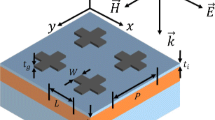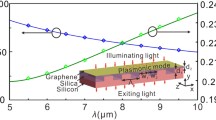Abstract
The sensitivity of the surface plasmon polariton wave (SPPs) is coherently controlled and modified at the interface of four-level Doppler broadening dielectric medium and graphene. The useful control over the sensitivity of the SPPs under the Doppler broadening dielectric medium with system and driving fields parameters is reported. The sensitivity of SPPs is a function of probe and control field detuning, control field Rabi frequency, and decay rates. The high value of sensitivity is reported to 2700 deg/RIU with phase and decay rate, while small value of sensitivity is investigated to 320 deg/RIU with control field detuning. The above results show useful applications in biosensor, data storage, waveguiding, and solar cells.





Similar content being viewed by others
Data Availability
No data was used in this study.
References
Tame MS, McEnery KR, Özdemir ŞK, Lee J, Maier SA, Kim MS (2013) Quantum plasmonics. Nat Phys 9(6):329–340. https://doi.org/10.1038/nphys2615
Khan Q, Bacha BA, Ahmad I et al (2023) Manipulation of sensitivity of the surface plasmon polariton waves at the interface of high magneto-optical medium and silver metal using angular interrogation. Results Phys 52:106844
Khan N, Bacha BA, Iqbal A, Rahman AU, Afaq A (2017) Gain-assisted superluminal propagation and rotary drag of photon and surface plasmon polaritons. Erratum Phys Rev A. https://doi.org/10.1103/PhysRevA.96.013848
Zhang T, Shan F (2014) Development and application of surface plasmon polaritons on optical amplification. Nanomaterials. https://doi.org/10.1155/2014/495381
Anker JN, Hall WP, Lyandres O, Shah NC, Zhao J, Van Duyne RP (2008) Biosensing with plasmonic nanosensors. Nat Mater. https://doi.org/10.1038/nmat2162
Atwater H, Polman A (2010) Plasmonics for improved photovoltaic devices. Nat Mater 9:205–213. https://doi.org/10.1038/nmat2629
Linic S, Christopher P, Ingram DB (2011) Plasmonic-metal nanostructures for efficient conversion of solar to chemical energy. Nat Mater 10(12):911–921. https://doi.org/10.1038/nmat3151
Han Z, Bozhevolnyi SI (2013) Radiation guiding with surface plasmon polariton. Rep Prog Phys 76:016402. https://doi.org/10.1088/0034-4885/76/1/016402
Gobin AM, Lee MH, Halas NJ, James WD, Drezek RA, West JL (2007) Near-infrared resonant nanoshells for combined optical imaging and photothermal cancer therapy. Nano Lett 7:1929–1934. https://doi.org/10.1021/nl070610y
Reece PJ (2008) Plasmonics-finer optical tweezers. Nature Publishing Group. https://condmat.physics.manchester.ac.uk/pdf/mesoscopic/news/graphene/ Naturephot. Accessed June 2008
Juan ML, Righini M, Quidant R (2011) Plasmon nano-optical tweezers. Nat Photonics 5:349–356. https://doi.org/10.1038/nphoton.2011.56
Mecklenburg M, Hubbard WA, White ER, Dhall R, Cronin SB, Aloni S, Regan BC (2015) Thermal measurement. Nanoscale temperature mapping in operating microelectronic devices. Science (New York, N.Y.). https://doi.org/10.1126/science.aaa2433cience
Goykhman B, Desiatov JB, Khurgin J, Shappir U (2011) Levy, locally oxidized silicon surface-plasmon schottky detector for telecom regime. Nano Lett. https://doi.org/10.1021/nl200187v
Shalabney A, Abdulhalim I (2011) Sensitivity-enhancement methods for surface plasmon sensors. Laser Photonics Rev 5:571–606
Rossi S, Gazzola E, Capaldo P, Borile G, Romanato F (2018) Grating-coupled surface plasmon resonance (GC-SPR) optimization for phase-interrogation biosensing in a microfluidic chamber. Sensors 18:1621
Homola J, Yee SS, Gauglitz G (1999) Surface plasmon resonance sensors: a review. Sens Actuators B Chem 54:3–15
Zeng S, Baillargeat D, Ho H-P, Yong K-T (2014) Chem Soc Rev 43:3426. https://doi.org/10.1039/c3cs60479a
Fermi E (1932) Quantum theory of radiations. Rev Mod Phys 4(1):87–132
Dicke RH (1953) The effect of collisions upon the Doppler width of spectral lines. Phys Rev 89(2):472–473
Agarwal GS, Dey TN (2003) Slow light in Doppler-broadened two-level systems. Phys Rev A 68(6):063816(1–4)
Fan X, Liu Z, Liang Y, Jia K, Tong D (2011) Phase control of probe response in a Doppler-broadened N-type four-level system. Phys Rev A 83(4):043805(1–10)
Bacha BA, Jabar MSA (2018) The event cloaking from a birefringent medium via Kerr nonlinearity. J Opt 20:095703
Khan L, Bacha BA, Wahid U, Ullah A (2020) Birefringence of rotary photon drags through induced chiral atomic medium Phys. Scr. 95:7
Khan Q, Khan A, Bacha BA et al (2023) Sensitivity of the surface plasmon polariton waves at the interface of metal and dielectric medium using doppler broadening effect. Plasmonics. https://doi.org/10.1007/s11468-023-01978-8
Khan Q, Khan A, Bacha BA et al (2023) Conductivity dependent sensitivity of the surface plasmon polariton waves at the interface of metal and dielectric using wavelength interrogation. Plasmonics. https://doi.org/10.1007/s11468-023-02134-y
Homola J, Yee SS, Myszka D (2008) Opt Biosensors 13:185
Khan Q, Gul Z, Khan M et al (2024) Coherent control of angular interrogation of sensitivity of the surface plasmon polariton waves at the interface of metal and dielectric medium. Plasmonics. https://doi.org/10.1007/s11468-024-02202-x
Author information
Authors and Affiliations
Contributions
Qaisar Khan did the primary work and performed all the simulation, and Meraj Ali Khan and Asghar Ali review the paper. All authors read the article and helped in improving it.
Corresponding author
Ethics declarations
Conflict of Interest
The authors declare no competing interests.
Additional information
Publisher's Note
Springer Nature remains neutral with regard to jurisdictional claims in published maps and institutional affiliations.
Appendix
Appendix
The coupled rate equations are given as
The parameters \(A_{1-4}\) are written below:
Rights and permissions
Springer Nature or its licensor (e.g. a society or other partner) holds exclusive rights to this article under a publishing agreement with the author(s) or other rightsholder(s); author self-archiving of the accepted manuscript version of this article is solely governed by the terms of such publishing agreement and applicable law.
About this article
Cite this article
Khan, Q., Ali Khan, M. & Ali, A. Surface Plasmon Resonance Sensing at the Interface of Doppler Broadening Dielectric Medium and Graphene. Plasmonics (2024). https://doi.org/10.1007/s11468-024-02300-w
Received:
Accepted:
Published:
DOI: https://doi.org/10.1007/s11468-024-02300-w




